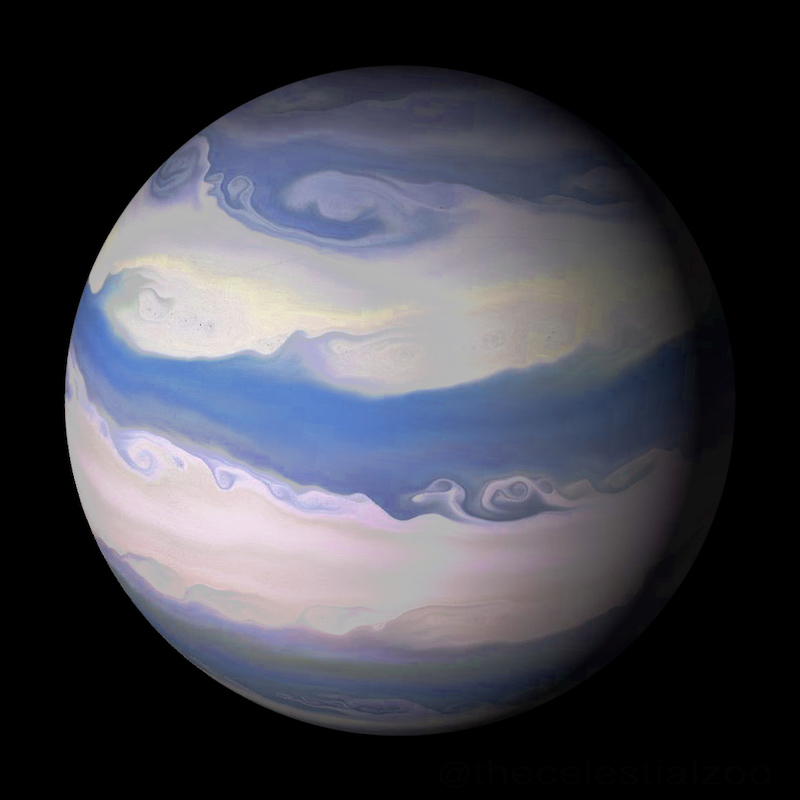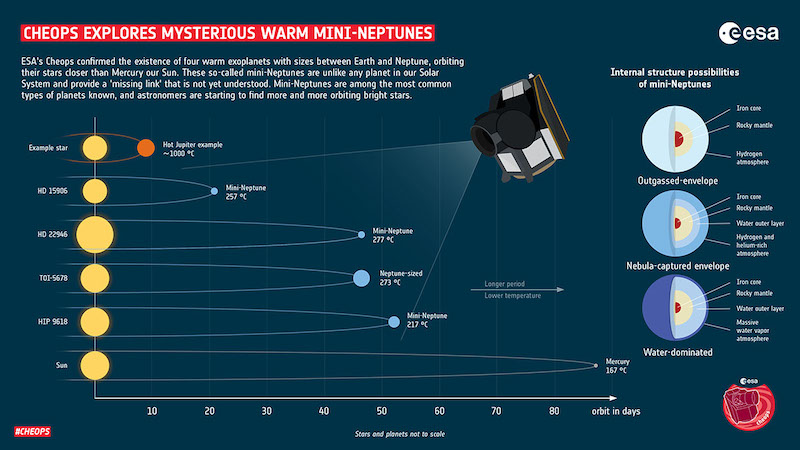
On June 8, 2023, researchers at the University of Bern and University of Geneva announced that they’ve discovered four new exoplanets. Using data from the CHEOPS space telescope, they found four mini-Neptunes, planets that are less massive than Neptune but significantly more massive than Earth. The planets played hide and seek with the astronomers. Earlier detections with NASA’s TESS space telescope showed that two of them existed, but they were elusive. Subsequent observations found them again, but confirmation was still difficult until CHEOPS proved they really are there, along with two other similar planets.
The researchers published their peer-reviewed findings in four new papers in Astronomy & Astrophysics and Monthly Notices of the Royal Astronomical Society on June 8, 2023. You can read them here, here, here and here.
TESS spots 1st 2 mini-Neptunes
TESS first detected the transits of two of the planets, TOI 5678 b and HIP 9618 c. Both are smaller than Neptune, with 4.9 and 3.4 Earth radii respectively. TESS discovered the planets using the transit method. This method is when a planet transits in front of its star, as we see it from Earth. It’s a good method for planets that orbit closer to their stars, but not as ideal for planets orbiting farther out. Hugh Osborn at the University of Bern and NCCR PlanetS, and lead author of one of the papers, explained:
NASA’s TESS satellite excels at detecting the transits of exoplanets, even for the most challenging small planets. However, it changes its field of view every 27 days in order to scan rapidly most of the sky, which prevents it from finding planets on longer orbital periods.
TESS observed single transits for both planets around their host stars. It saw the transits again two years later. That’s impressive, although still not conclusive of the planets’ existence.
CHEOPS takes a look
Subsequently, astronomers used CHEOPS to try to also detect the planets. CHEOPS’ advantage is that it observes a single star at a time, in-depth. Solène Ulmer-Moll at the University of Geneva, University of Bern and NCCR PlanetS, and lead author of one of the papers, said:
This is where CHEOPS comes into play: Focusing on a single star at a time, CHEOPS is a follow-up mission which is perfect to continue observing these stars to find the missing bits of information.
And it worked! CHEOPS successfully detected both planets, although it took four and five attempts for TOI 5678 b and HIP 9618 c respectively. TOI 5678 b orbits its star in 48 days, and HIP 9618 c completes an orbit in 52.5 days.
Osborn said:
We point CHEOPS toward a target at a given time, and depending if we observe a transit or not, we can eliminate some of the possibilities and try again at another time until there is a unique solution for the orbital period.
In addition, Amy Tuson from the University of Cambridge in the U.K. and Zoltán Garai from the ELTE Gothard Astrophysical Observatory in Hungary found two other similar planets orbiting other stars. Those planetary systems are HD 22946 and HD 15906. They used the same technique to identify them that the astronomers used for the previous two mini-Neptunes.
With the new data, the researchers also determined the masses for TOI 5678 b and HIP 9618 c. They are 20 and 7.5 Earth masses, respectively.

Ideal targets for Webb Space Telescope
Both TOI 5678 b and HIP 9618 c are ideal targets for the Webb Space Telescope. Ulmer-Moll said:
Since the four newly discovered exoplanets are orbiting bright stars, it also makes them targets of prime interest for the mission of the James Webb Space Telescope, which might help to solve the riddle of their composition.
Astronomers should then be able to figure out what the planets are composed of. Ulmer-Moll added:
For mini-Neptunes however, density is not enough, and there are still a few hypotheses as for the composition of the planets. They could either be rocky planets with a lot of gas, or planets rich in water and with a very steamy atmosphere.
Osborn added:
The four new planets that we detected have much more moderate temperatures of ‘only’ 217 to 277 C. These temperatures enable clouds and molecules to survive, which would otherwise be destroyed by the intense heat of Hot Jupiters. And they may potentially be detected by the JWST.
Bottom line: Astronomers using the CHEOPS space telescope have confirmed the existence of four new mini-Neptunes. Confirming them was like a game of hide and seek.
TOI-5678b: A 48-day transiting Neptune-mass planet characterized with CHEOPS and HARPS
Refined parameters of the HD 22946 planetary system and the true orbital period of the planet d
Two Warm Neptunes transiting HIP 9618 revealed by TESS & CHEOPS
TESS and CHEOPS Discover Two Warm Mini-Neptunes Transiting the Bright K-dwarf HD15906
The post 4 mini-Neptunes play hide and seek first appeared on EarthSky.
0 Commentaires